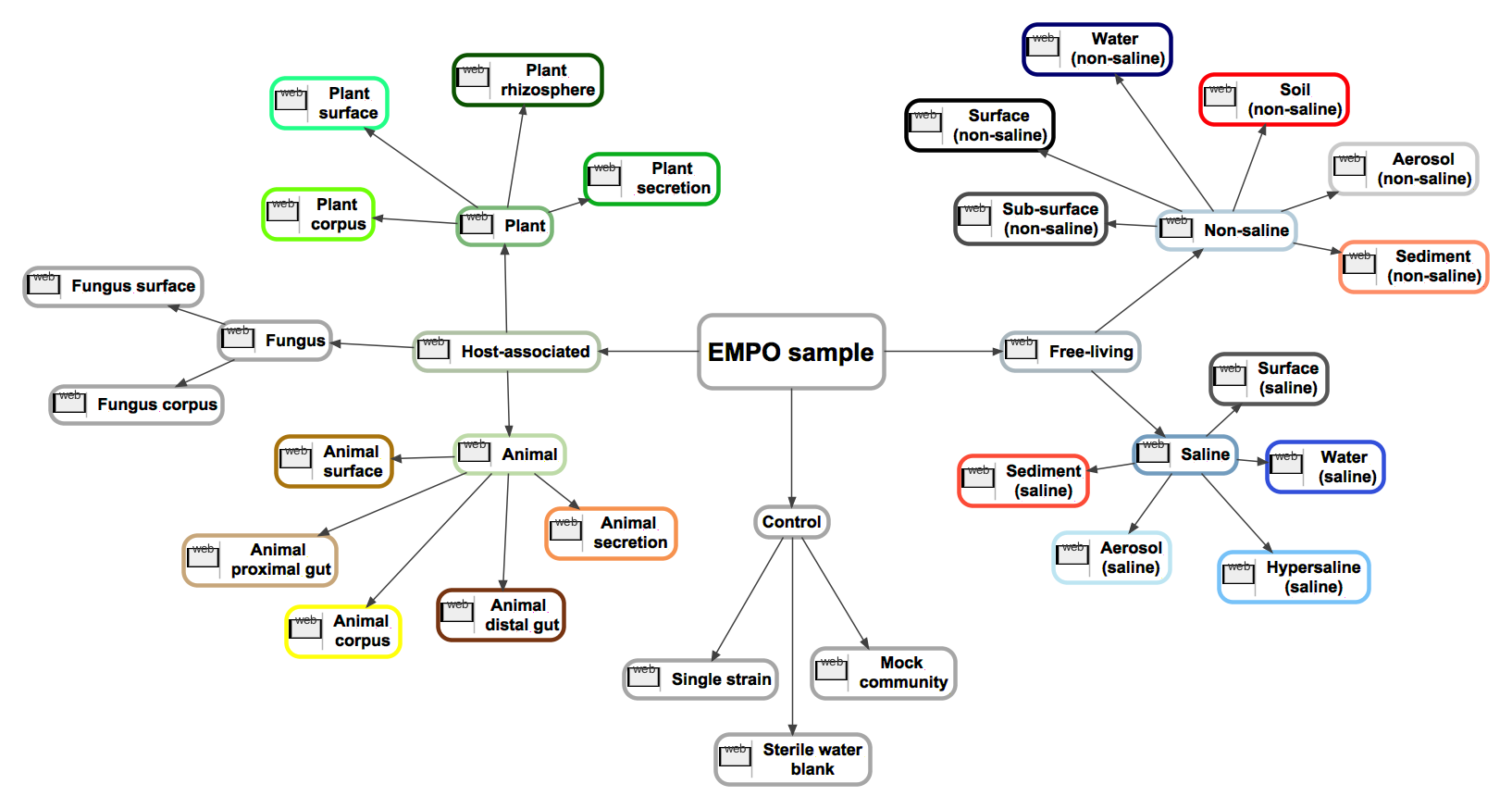The EMP Ontology (EMPO) is built upon existing ontologies and is used to assign samples to habitats in a hierarchical framework that captures major axes of microbial community diversity. Four fields are used: empo_0 (level 0: root), empo_1 (level 1: Free-living, Host-associated, Control, or Unknown), empo_2 (level 2: Saline, Non-saline, Animal, Plant, or Fungus), and empo_3 (level 3: most specific habitat name).
The network diagram below shows the relationships between EMPO classes, which are linked to ENVO and other ontology classes. A VUE file and text file describing the ontology can be downloaded here.

The table below shows examples of how different sample types are classified under the EMPO system.
| empo_1 | empo_2 | empo_3 | Examples |
|---|---|---|---|
| Free-living | Non-saline | Water (non-saline) | fresh water from lake, pond, river (<5 psu) |
| Free-living | Non-saline | Sediment (non-saline) | sediment from lake, pond, river (<5 psu) |
| Free-living | Non-saline | Soil (non-saline) | soil from forest, grassland, tundra, desert, etc. |
| Free-living | Non-saline | Surface (non-saline) | biofilm from wet (<5 psu) or dry surface, wood, dust, microbial mat |
| Free-living | Non-saline | Subsurface (non-saline) | deep or subsurface environment |
| Free-living | Non-saline | Aerosol (non-saline) | aerosolized dust or liquid |
| Free-living | Saline | Water (saline) | salt water from ocean, sea, estuary, mangrove, coral reef (>5 psu) |
| Free-living | Saline | Sediment (saline) | sediment from ocean, sea, estuary, mangrove, beach (>5 psu) |
| Free-living | Saline | Hypersaline (saline) | water from hypersaline sample or brine (>50 psu) |
| Free-living | Saline | Surface (saline) | biofilm from wet or underwater surface or microbial mat (>5 psu) |
| Free-living | Saline | Aerosol (saline) | seaspray or other aerosolized saline material (>5 psu) |
| Host-associated | Animal | Animal distal gut | feces, stool |
| Host-associated | Animal | Animal proximal gut | gut intestine, gizzard, crop, lumen, mucosa |
| Host-associated | Animal | Animal secretion | saliva, breast milk, vaginal secretion |
| Host-associated | Animal | Animal surface | skin, sebum, mucus, slime |
| Host-associated | Animal | Animal corpus | tissue of sponge, coral, gill, siphon, carcass, etc. or whole small animal |
| Host-associated | Plant | Plant secretion | pollen, sap |
| Host-associated | Plant | Plant surface | leaf or kelp surface biofilm |
| Host-associated | Plant | Plant rhizosphere | plant root system, may include some soil |
| Host-associated | Plant | Plant corpus | tissue of leaf, stem, fruit, algae |
| Host-associated | Fungus | Fungus corpus | tissue of mushroom or other fungi |
| Host-associated | Fungus | Fungus surface | biofilm of mushroom |
| Control | Negative | Sterile water blank | sterile water blank used as negative control for extraction, PCR, and sequencing |
| Control | Positive | Single strain | known single strain used as positive control |
| Control | Positive | Mock community | known mixed community used as positive control |
| Unknown | Contradictory | Unknown (contradictory) | unknown sample type because other metadata is contradictory |
| Unknown | Missing | Unknown (missing) | unknown sample type because metadata is unavailable |